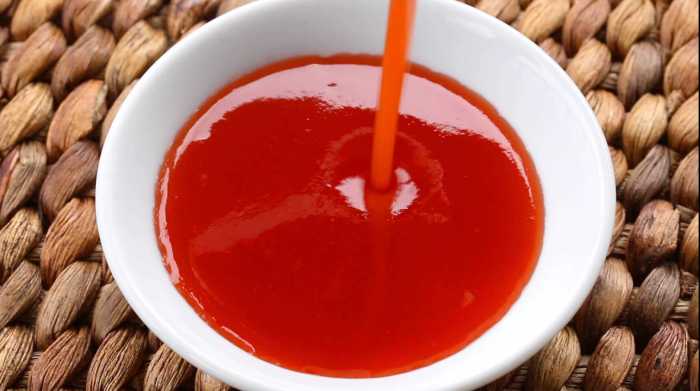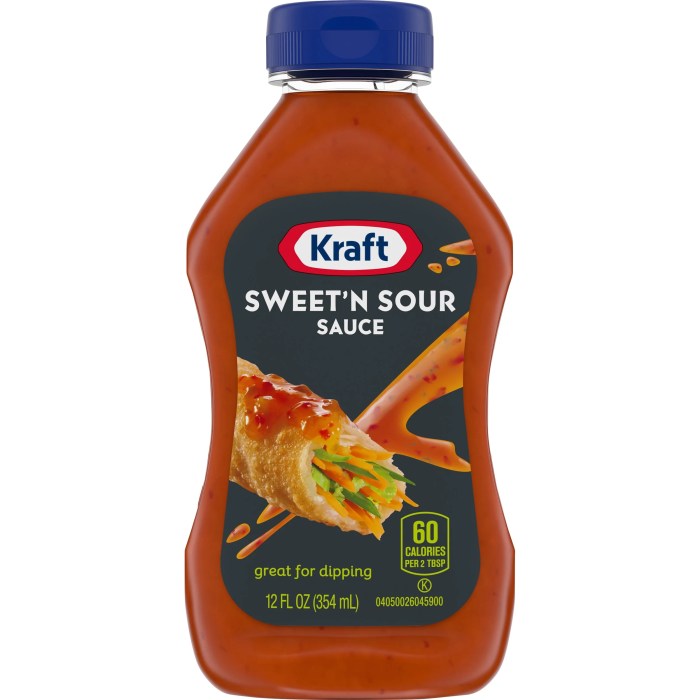
Sweet and Sour Sauce: A Culinary Journey
Sweet and sour sauce i – Sweet and Sour Sauce: A Culinary Journey takes you on a flavorful adventure through the history, ingredients, and cultural variations of this beloved condiment. From its ancient origins to its modern-day popularity, sweet and sour sauce has captured palates and hearts worldwide.
This versatile sauce, with its perfect balance of sweet, sour, and savory notes, has become a staple in countless cuisines, adding a burst of flavor to everything from stir-fries and dumplings to meat dishes and even desserts. Join me as we explore the fascinating world of sweet and sour sauce, uncovering its secrets and discovering its enduring appeal.
Sweet and Sour Sauce History
Sweet and sour sauce, a culinary staple in many cuisines worldwide, boasts a rich and fascinating history, tracing its roots back to ancient civilizations. Its evolution reflects the confluence of culinary traditions, cultural exchanges, and the innovative spirit of cooks across continents.
Origins in Ancient Civilizations
The concept of sweet and sour flavors is deeply ingrained in culinary traditions across the globe. Ancient civilizations, from China to the Mediterranean, employed combinations of sweet, sour, and savory flavors in their cooking.
- In ancient China, sweet and sour sauces were used as early as the Han Dynasty (206 BC – 220 AD). These sauces often featured a combination of vinegar, sugar, soy sauce, and spices, and were used to marinate meats, vegetables, and fish.
- Ancient Greeks and Romans also incorporated sweet and sour flavors into their cuisine. They used honey, vinegar, and herbs to create sauces that complemented both meat and fish dishes.
Ingredients and Flavor Profile
Sweet and sour sauce is a culinary staple, renowned for its unique blend of sweet, sour, and savory flavors. Its versatility makes it a perfect complement to a wide array of dishes, from stir-fries and dumplings to meats and seafood.
Primary Ingredients
The key ingredients in sweet and sour sauce create its characteristic flavor profile.
- Vinegar:The primary source of sourness, vinegar provides a sharp and tangy note that balances the sweetness. Common types include rice vinegar, white vinegar, and apple cider vinegar.
- Sugar:The sweetness is typically achieved with granulated sugar, though brown sugar, honey, or corn syrup can be used for a deeper flavor.
- Soy Sauce:This salty and savory ingredient adds umami depth and a complex flavor profile.
- Ketchup:Ketchup provides a touch of sweetness, acidity, and a rich tomato flavor.
- Other Ingredients:Additional ingredients, such as cornstarch or arrowroot powder for thickening, garlic, ginger, and chili peppers for added complexity, can be incorporated to enhance the sauce’s flavor and texture.
Flavor Profile
Sweet and sour sauce is characterized by its well-balanced blend of flavors:
- Sweetness:The sugar provides a sweet base that balances the sourness and enhances the overall taste.
- Sourness:The vinegar contributes a sharp and tangy sourness that contrasts the sweetness, creating a dynamic flavor profile.
- Savory:Soy sauce adds a depth of umami, enriching the overall flavor and providing a savory note.
- Other Flavors:The inclusion of ingredients like garlic, ginger, and chili peppers introduces additional nuances, adding complexity and warmth to the sauce.
Ingredient Contributions to Flavor and Texture
The different ingredients in sweet and sour sauce play crucial roles in its overall flavor and texture.
I love the tangy sweetness of a good sweet and sour sauce, but sometimes I crave something a little more comforting. That’s when I turn to a classic summer dessert like Easy Fresh Peach Cobbler: A Summertime Delight , which is perfect for enjoying with a scoop of vanilla ice cream.
After all, a little sweetness goes a long way, whether it’s in a sauce or a cobbler.
- Vinegar:The vinegar provides a sharp, tangy flavor that cuts through the sweetness and adds a refreshing element to the sauce. It also contributes to the sauce’s thin consistency.
- Sugar:Sugar provides sweetness, balancing the sourness and creating a harmonious flavor profile. It also helps to thicken the sauce.
- Soy Sauce:Soy sauce adds a savory depth and umami flavor, making the sauce more complex and appealing. It also contributes to the sauce’s salty flavor.
- Ketchup:Ketchup adds a touch of sweetness and acidity, along with a rich tomato flavor that enhances the overall taste. It also contributes to the sauce’s thickness.
- Cornstarch or Arrowroot Powder:These thickening agents create a smooth, velvety texture that coats the food and enhances the sauce’s ability to cling to ingredients.
- Garlic and Ginger:These aromatic ingredients add a pungent, savory, and slightly spicy flavor that enhances the sauce’s complexity.
- Chili Peppers:Chili peppers introduce a touch of heat and spiciness, adding a dynamic element to the sauce.
Regional Variations

Sweet and sour sauce, despite its seemingly simple nature, exhibits a fascinating array of regional variations that reflect the diverse culinary traditions and ingredient availability around the world. From the tangy and spicy notes of Southeast Asian versions to the sweet and savory flavors of Chinese-inspired sauces, each region has its own unique take on this beloved condiment.
Sweet and sour sauce is a versatile condiment that can be used in many dishes, but I recently discovered a recipe that really brought out its flavor: a hearty Mennonite Cabbage Potato Kielbasa Bake. The tangy sauce paired perfectly with the rich kielbasa and the savory cabbage, creating a truly satisfying meal.
I can’t wait to try it again soon, maybe even with a side of sweet and sour pork!
Chinese Sweet and Sour Sauce
The Chinese sweet and sour sauce, often referred to as “sweet and sour pork sauce,” is a classic example of this culinary diversity. It typically features a balance of sweet, sour, and savory flavors, achieved through the use of ingredients like sugar, vinegar, soy sauce, and cornstarch.
The preparation of this sauce varies depending on the region and the specific dish it accompanies. For instance, in Cantonese cuisine, the sauce is often lighter and more delicate, with a focus on the balance of sweet and sour notes.
In contrast, the Sichuan version might incorporate chili peppers and other spices, resulting in a spicier and more complex flavor profile.
“The Chinese sweet and sour sauce is a testament to the versatility and adaptability of this condiment, showcasing how regional preferences and culinary traditions shape its unique characteristics.”
Southeast Asian Sweet and Sour Sauce
Southeast Asian sweet and sour sauce, particularly prevalent in Thai, Vietnamese, and Filipino cuisine, offers a distinct flavor profile characterized by its tangy, spicy, and slightly sweet notes. The use of ingredients like tamarind, lime juice, fish sauce, and chili peppers contributes to its vibrant and complex flavor.The preparation of this sauce often involves simmering the ingredients in a pan until they reduce and thicken, resulting in a glossy and flavorful sauce.
I’m always on the lookout for new ways to use sweet and sour sauce, and recently I stumbled upon a recipe that truly blew me away: Jens Heavenly Egg Salad: A Culinary Masterpiece. The combination of the tangy sauce with the creamy egg salad is a match made in heaven, and I can’t wait to experiment with different variations of this delicious dish.
Maybe a touch of sweet and sour sauce would even elevate this classic recipe to new heights!
It is commonly used as a marinade for meats, as a dipping sauce for fried dishes, or as a glaze for grilled or roasted vegetables.
“The Southeast Asian sweet and sour sauce exemplifies how the culinary traditions of a region can influence the flavor profile and use of this versatile condiment.”
American Sweet and Sour Sauce
American sweet and sour sauce, popularized by Chinese-American restaurants, is a unique variation that often features a sweeter and less tangy flavor profile compared to its Chinese counterparts. It typically relies on a combination of sugar, vinegar, ketchup, and cornstarch to achieve its characteristic flavor.The American version is often used as a glaze for fried dishes, such as sweet and sour chicken or pork, and is known for its thick, syrupy consistency.
It is also commonly served as a dipping sauce for appetizers and snacks.
“The American sweet and sour sauce reflects the fusion of culinary influences and the adaptation of traditional recipes to suit local tastes.”
Culinary Applications: Sweet And Sour Sauce I

Sweet and sour sauce, with its harmonious blend of tangy, sweet, and savory notes, transcends the boundaries of a simple condiment, finding its place as a versatile ingredient in a multitude of culinary applications. From classic dishes to innovative creations, sweet and sour sauce adds a delightful dimension to various cuisines.
Popular Dishes Featuring Sweet and Sour Sauce
Sweet and sour sauce is a staple in many cuisines, often gracing the plates of popular dishes.
- Sweet and Sour Pork:A quintessential Chinese dish, sweet and sour pork features tender pork coated in a crispy batter and enveloped in a luscious sweet and sour sauce.
- Sweet and Sour Chicken:A variation on the classic sweet and sour pork, sweet and sour chicken features tender chicken pieces coated in a crispy batter and bathed in the same flavorful sweet and sour sauce.
- Sweet and Sour Fish:A delightful combination of sweet and sour sauce and flaky fish, this dish offers a refreshing take on the classic sweet and sour flavor profile.
- Sweet and Sour Shrimp:Similar to its counterparts, sweet and sour shrimp combines tender shrimp with the signature sweet and sour sauce, creating a delightful and flavorful dish.
- Sweet and Sour Vegetables:A vegetarian twist on the classic sweet and sour dish, this variation features a medley of vegetables coated in a sweet and sour sauce, offering a vibrant and flavorful experience.
Sweet and Sour Sauce as a Marinade
Sweet and sour sauce can be used as a marinade to infuse dishes with its signature flavor profile.
- Chicken Marinade:Marinating chicken in sweet and sour sauce before grilling or baking adds a tangy and sweet dimension to the chicken, enhancing its flavor and tenderness.
- Pork Marinade:Marinating pork in sweet and sour sauce can tenderize the meat while imparting a delightful sweet and sour flavor. This marinade is particularly well-suited for pork chops, tenderloin, or ribs.
- Fish Marinade:Sweet and sour sauce can be used to marinate fish, adding a tangy and sweet element to the fish’s natural flavor. This marinade is especially suitable for firm-fleshed fish like halibut, cod, or sea bass.
Sweet and Sour Sauce as a Glaze, Sweet and sour sauce i
Sweet and sour sauce can be used as a glaze to create a visually appealing and flavorful finish for various dishes.
- Glazed Chicken:Applying a sweet and sour glaze to roasted or grilled chicken during the final stages of cooking adds a glossy finish and intensifies the chicken’s flavor.
- Glazed Pork:Similar to chicken, a sweet and sour glaze can be applied to pork during the final stages of cooking to create a flavorful and visually appealing finish.
- Glazed Vegetables:A sweet and sour glaze can be used to add a touch of sweetness and tanginess to roasted or grilled vegetables.
Sweet and Sour Sauce as a Dipping Sauce
Sweet and sour sauce is a popular dipping sauce for various dishes, offering a delightful balance of sweet, sour, and savory flavors.
- Spring Rolls:Sweet and sour sauce is a classic dipping sauce for spring rolls, providing a tangy and sweet counterpoint to the crisp vegetables and savory fillings.
- Dumplings:Sweet and sour sauce is a popular dipping sauce for dumplings, offering a delightful balance of sweet, sour, and savory flavors that complement the savory filling.
- Fried Foods:Sweet and sour sauce can be used as a dipping sauce for fried foods, such as chicken wings, onion rings, or tempura, offering a refreshing contrast to the crispy texture.
Making Sweet and Sour Sauce at Home
Creating your own sweet and sour sauce is a rewarding culinary adventure, allowing you to customize the flavors to your liking and enjoy the satisfaction of homemade goodness. With a few key ingredients and a bit of time, you can achieve the perfect balance of sweet, sour, and savory notes that define this classic sauce.
Basic Sweet and Sour Sauce Recipe
This recipe provides a foundational base for your sweet and sour sauce, offering a balanced flavor profile that can be further customized to your preferences.
Ingredients:
- 1 cup white vinegar
- 1 cup granulated sugar
- 1/2 cup ketchup
- 1/4 cup soy sauce
- 1 tablespoon cornstarch
- 1 teaspoon ground ginger
- 1/2 teaspoon garlic powder
- 1/4 teaspoon black pepper
Instructions:
- In a medium saucepan, whisk together the vinegar, sugar, ketchup, soy sauce, cornstarch, ginger, garlic powder, and black pepper.
- Bring the mixture to a boil over medium heat, stirring constantly.
- Reduce the heat to low and simmer for 5-7 minutes, or until the sauce has thickened.
- Remove from heat and let cool slightly before serving.
Tips and Techniques for Achieving the Desired Flavor and Consistency
- Adjust the sweetness:If you prefer a sweeter sauce, increase the amount of sugar. For a less sweet version, reduce the sugar or substitute with honey or agave nectar.
- Control the sourness:Adjust the vinegar content to achieve your desired level of sourness. White vinegar provides a sharp acidity, while apple cider vinegar offers a milder, fruitier taste.
- Enhance the savory notes:Adding a pinch of salt can enhance the savory notes of the sauce. Experiment with different types of soy sauce for varying levels of umami.
- Achieve the perfect consistency:The cornstarch helps thicken the sauce. If you find it too thin, add a little more cornstarch, whisking it into the sauce before returning it to the heat.
Variations and Customizations
- Fruity additions:Incorporate chopped pineapple, mango, or other fruits for a tropical twist.
- Spicy kick:Add a pinch of red pepper flakes or a dash of hot sauce for a spicy edge.
- Herbs and spices:Experiment with different herbs and spices, such as cinnamon, star anise, or sesame oil, to create unique flavor profiles.
- Vegetarian options:Substitute fish sauce for soy sauce for a vegetarian-friendly version.
Sweet and Sour Sauce in Popular Culture
Sweet and sour sauce, a culinary staple in many cuisines, has also found its way into popular culture, becoming a symbol of both nostalgia and culinary exploration. From movies and television shows to literature, this versatile condiment has captured the imagination of audiences worldwide.
Sweet and Sour Sauce in Film and Television
The appearance of sweet and sour sauce in film and television reflects its widespread popularity and cultural significance. It often serves as a culinary backdrop, representing a specific cultural identity or a universal taste preference.
- In the 1984 film -The Karate Kid*, the character Mr. Miyagi uses sweet and sour sauce as a metaphor for life’s challenges, emphasizing the balance between sweetness and sourness.
- The 2004 film -Mean Girls* features a memorable scene where the character Janis Ian uses sweet and sour sauce as a weapon, highlighting the sauce’s versatility and unexpected uses.
- The popular television series -Friends* frequently features sweet and sour sauce, often as a comedic element, showcasing its familiarity and everyday presence in American culture.






